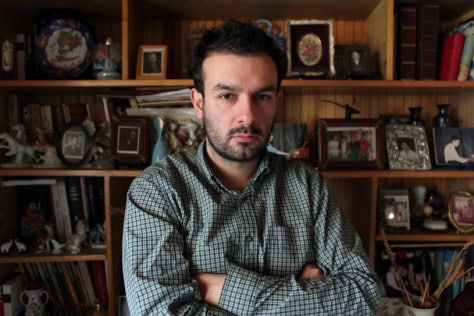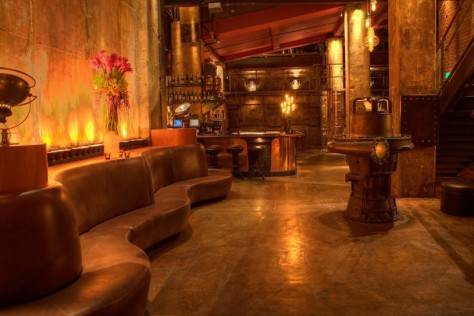Kehinde Wiley made a monumental splash when he started painting hip-hop’s leading lights in the style of traditional, Old Master-style portraiture. He’s since moved beyond rap icons, but has still remained committed to introducing thorny issues of how gender and identity is presented against the backdrop of art history. His most recent solo show was at Deitch Projects. We caught up with Wiley while he was at Miami Basel and found out why he doesn’t even think hip-hop exists anymore (and how Jeff Koons has more to do with the genre than he does.)
So, how’s Miami?
It’s good. It’s a lot, but it’s good.
To start, I was just curious what your earliest connections are to hip-hop—what was the first music you encountered?
Wow. I don’t think I have any relation to hip hop necessarily, thinking about my artistic start. I remember being a contrarian, really sort of pushing myself to like jazz. I discovered hip-hop when I was in college, which was a little bit strange for a young kid growing up in South Central Los Angeles back in the ‘80s. I think it was part of the contrarian nature of a young artist trying to carve his own sense of identity. And it was about, you know, sort of teenage rebellious angst. And so I was listening to Tera Vaughn when Biggie was on. I was listening to Louie Armstrong when Tupac was out. That said, I wasn’t completely ignorant to what the broader culture was doing. I just didn’t really have much of an interest in it.
Was there an element of hip-hop culture, historically, that you were trying to present in some of those early portraits?
I try to recognize the sacred in the most common places; I just start with an African American community that I belong to. You know, much of what I do is I quote old paintings, and the old paintings are repopulated with young African American men who follow a very straight ahead demographic, between the ages of 18 and 25. It’s obviously a comment on youth culture and it’s a comment on consumption patterns, but it’s also a comment on who gets to be in those sort of important moments in picture making.
Do you think there’s that same sort of fluidity now, between maybe a street art, public art movement and a fine art movement, that there was when Haring and Basquiat were around? [What about the idea of how] hip-hop is kind of an anti-elitist movement, something that everyone can be involved in, it’s very democratic, you don’t need all this formal training…
I think that that idea has proven to be pretty bankrupt at this point. I mean we’re noticing now that the corporatization of hip-hop is occurring in much the same way as mainstream rock. It’s business, and there’s channels that must be navigated, much like in the art world. At this point, [hip-hop] culture has evolved to a point where it has its own corridors of power, its own protocols, its own leader. And much like any system, those things are meant to be broken. And we’ll probably see an answer to that; we’ll probably see a younger generation who defines what the nature of hip-hop is.
I don’t even think that hip-hop is a function of the culture that is being produced by and large by young brown and black people all over the world. I think we’re post hip-hop. And I think it’s sort of a quaint idea that we would even be having this conversation about how hip-hop can necessarily function in the art world, because I think hip-hop is no longer with us.
Because it’s calcified into a corporate thing, you’re saying?
Certainly. And the strength of hip hop was it’s oppositional stance. The strength of hip hop was that it was the periphery speaking to the center. At this point, hip-hop is institutionalized. Hip-hop is the center.
If you’re saying that hip-hop’s gone the way of the art world, that the art world definitely has it’s quarters of power and things like this, do you feel your own obligation as an artist to be constantly challenging that in the same way?
I think that any artist who ties themselves down to any sort of religious, gender, sexuality, or class obligations is making really uninteresting work. I’m beholden to no one. I think what I’m trying to do is scratch an itch, and when I’m at my best, I’m making stuff that just turns me on, and I hope that the world community responds to it. I’m just bored by this sort of preachy, didactic work that is so emblematic of the time that we had to do that. We don’t have to do that anymore. I remember there was this really insane show called “Freestyle” at The Studio Museum of Harlem, in which Thelma Goldman, who’s the director and curator there introduced this notion of post-blackness: ‘is it ever possible?’
Well the very utterance of ‘post-black’ includes the term ‘black,’ which means there’s a type of schizophrenia: the inability to recognize what one is, but also of a desire to go beyond it. I think that’s the constant state of people of color working within the fine arts; regardless of what you do with subject matter, it always comes down to something so essential about skin color, but the dream of the artist is always to go beyond that. To transcend expectations, to transcend class, race, gender, sexuality, class. But in the end when we are most honest with ourselves, we start with something very specific, very local, very personal. And that usually is strongly influenced by race, class, gender; it’s all in there.
There’s this guy named Richard Dyer who operates within this new field called ‘whiteness studies,’ in which he questions: “Do young white men from the 1950s make white boy art or do they simply function as agents who have certain dreams and certain desires in their work?” Well the answer can be yes in both cases. I think that obviously now we are in a much more sophisticated age in which we can see the work through so many different rubrics, including the fabrication of race, lightness, maledom, heterosexuality and so on. But at the same time when we look at Pollock, we don’t think of race, but it’s so much a part of that radical freedom and maledom. A very American picture.
It’s part of this American dream that’s been the subject of the work from Warhol to Koons. Something in the type of absolute freedom, daffy, hilarious pleasure, consumption consumption consumption—and you see that [also] as the subject matter of so much of hip-hop. It’s about people who were left out, people who want to sort of push their egos out into the world and have this bombastic, self-pleasing, misogynistic presence. In that sense I think there’s a bigger correlation between Jeff Koons and hip-hop [than] my own work. I think there’s a bigger correlation between Andy Warhol and hip-hop than my own work, because what they do is amplify the type of heroic desire for cash and domination that hip-hop is so defined by.
As far as a ‘self-branding’?
That’s right. Shameless. And I love those two artists, I think that’s the brilliant part about it, because those are some of the corollaries that very few people draw, especially theorists, when they’re talking about the American dream—what they mean when they talk about artists and how they hold the mirror up to the world. Well hip-hop is basically symptomatic of the broader community and it’s not about a type of ghettoized corridor, where black people are talking to themselves.
On a simple, very superficial level, what’s the music that you are listening to at this point in your life that is inspiring you and that you feel is pushing things forward—rather than this stasis that maybe commercial hip-hop has become?
Music doesn’t inspire me so much. I read a lot. Ideas inspire me. Music is often there, and it’s often jazz and it’s often classical. Cccasionally it’s hip-hop, but not much.
 Q&A with Larry Gus
Q&A with Larry Gus We Own the Night: The Edison
We Own the Night: The Edison
No Comments